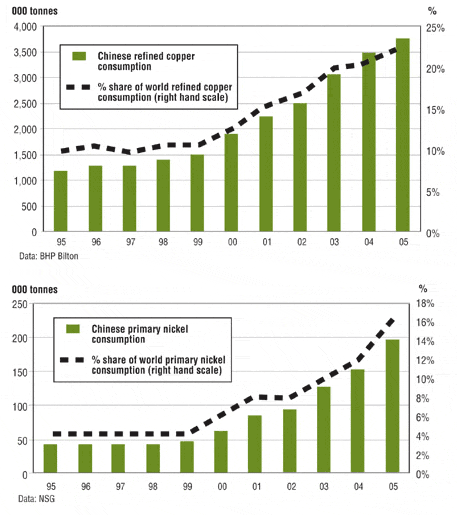|
|||||||||||||||||||||||||||||||||||||||||||||||||||||||||||||||||||||||||||||||||||||||||||||||||||||||||||||||||||||||||||||||||||||||||||||||||||||||||||||||||||||||||||||||||||||||||||||||||||||||||||
|
|||||||||||||||||||||||||||||||||||||||||||||||||||||||||||||||||||||||||||||||||||||||||||||||||||||||||||||||||||||||||||||||||||||||||||||||||||||||||||||||||||||||||||||||||||||||||||||||||||||||||||
| Demand, supply and prices | (in thousand tonnes unless mentioned) |
2005 |
2006 |
|||
| . |
2002 |
2003 |
2004 |
2005 |
(Jan-Apr) | (Jan-Apr) |
| Copper production |
15,269 |
15,234 |
15,823 |
16,446 |
5,310 |
5,621 |
| Copper consumption |
15,166 |
15,661 |
16,725 |
16,510 |
5,436 |
5,544 |
| Approx.Cu price(31 July; US$/tonne) |
$1,510 |
$1,770 |
$2,901 |
$3,760 |
$3,760 |
$7,850 |
| . | . | . | . | . | (Jan-May) | (Jan-May) |
| Zinc production |
9,710 |
9,871 |
10,357 |
10,261 |
4,268 |
4,350 |
| Zinc consumption |
9,377 |
9,848 |
10,656 |
10,636 |
4,366 |
4,470 |
| Approx.Zn price(31 July; US$/tonne) |
$757 |
$850 |
$1,017 |
$1,242 |
$1,242 |
$3,380 |
| . | . | . | . | . | (Jan-May) | (Jan-May) |
| Lead production |
6,670 |
6,748 |
6,955 |
7,556 |
3,060 |
3,363 |
| Lead consumption |
6,641 |
6,825 |
7,260 |
7,611 |
3,094 |
3,287 |
| Approx.Pb price(31 July;US$/tonne) |
$429 |
$517 |
$1,015 |
$870 |
$870 |
$1,111 |
| . | . | . | . | . | .. | 2006(e) |
| Nickel production |
1,182 |
1,201 |
1,256 |
1,285 |
. |
1,334 |
| Nickel consumption |
1,177 |
1,233 |
1,262 |
1,278 |
. |
1,364 |
| Approx. Ni price(31 July; US$/tonne) |
6,800 |
9,200 |
14,080 |
14,200 |
. |
$27,205 |
| . | . | . | . | . | .. | 2006(e) |
| Gold production (million ounces) |
108 |
111 |
107 |
109 |
. |
114 |
| Gold consumption |
82 |
79 |
81 |
83 |
. |
81 |
| Approx. Gold price(31 July; US$/ounce) |
$305 |
$355 |
$392 |
$430 |
. |
$635 |
| . | . | . | . | . | . | 2006(e) |
| Silver production (million ounces) |
739 |
743 |
753 |
791 |
. |
814 |
| Silver consumption |
791 |
788 |
801 |
806 |
. |
766 |
| Approx. Silver price(31 July; US$/ounce) |
$4.7 |
$5.1 |
$6.5 |
$7.2 |
. |
$11.4 |
| . To convert tonnes into pounds, multiply by 2,204.6; | ||||||
| . To convert US$/tonne into US$/pound, divide by 2,204.6; | ||||||
| . Production includes mined and recycled metal. | ||||||
| . Data sources: CPM group, ICSG, Inco, ILZSG, INSG, LME, and Kitco | ||||||
Base Metal Company Stocks
Consequently, we are holding off on buying any new base metal company stocks, unless the company has something of such extraordinary potential that we don't want to wait, or if a company also has a lot of precious metals, which hedges our base metal bet.
__________________________________________
We don't have anything base metal specific so how about if we go with the Shopping Season one that kind of covers everything?
Oil up, dollar down, the housing market on the brink of extinction... at least three good reasons to buy gold and silver on the current dips.
But aside from hoarding precious metals, you can profit even more from the emerging commodities bull market by investing in the little-known sector of junior exploration.
Right now is the perfect time to get into these underreported - and often undervalued-stocks. It's the Shopping Season, as Doug Casey likes to call it, the summer period during which the juniors spend their time digging and drilling, and very little news comes out of this corner of the stock market. Many investors confuse no news with bad news, and share prices are taking a nosedive.
Not forever, though. Once the summer is over, share prices will rise again - bringing smart speculators a much-appreciated windfall.
Learn more about those opportunities
here.
-Doug Casey
The International Speculator
![]()
Casey Archives


